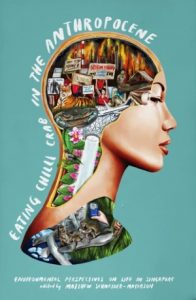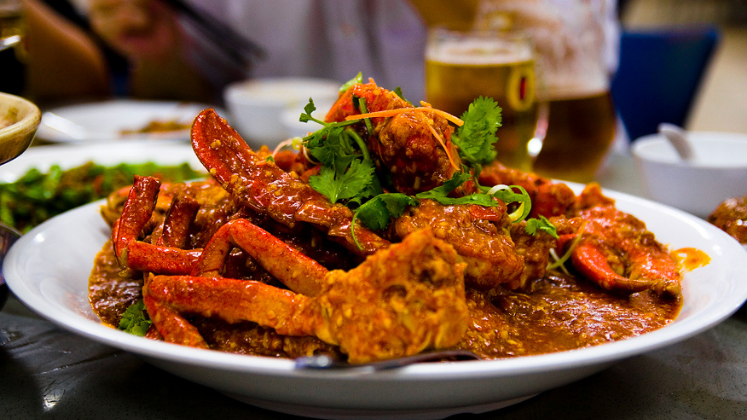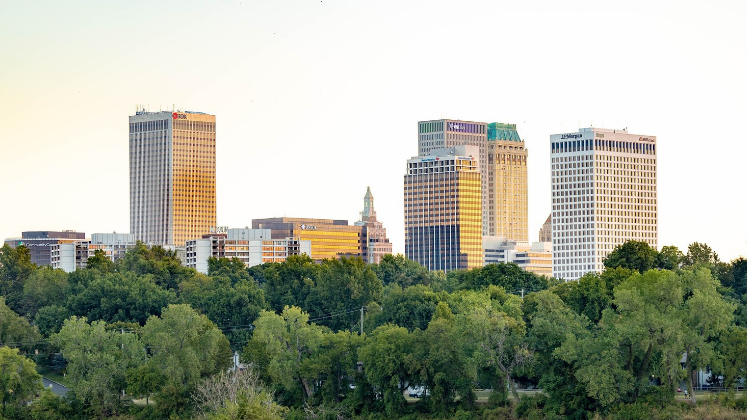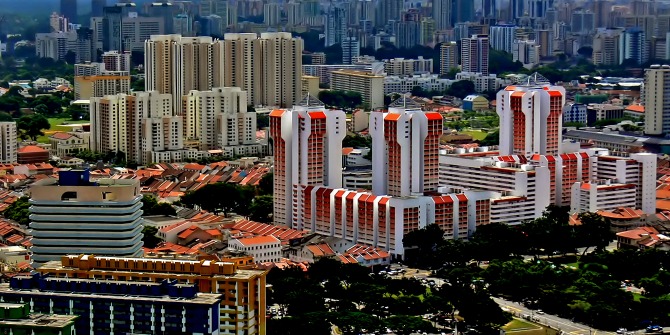In Eating Chilli Crab in the Anthropocene: Environmental Perspectives on Life in Singapore, editor Matthew Schneider-Mayerson weaves together a spirited anthology that looks at the broad web of life between and amongst human and non-human species in the island state with new eyes. The collection offers thought-provoking imaginaries and opens up an avenue of youthful hope for anyone concerned about the looming climate catastrophe, writes Alexandria Z.W. Chong.
This book review is published by the LSE Southeast Asia blog and LSE Review of Books blog as part of a collaborative series focusing on timely and important social science books from and about Southeast Asia.
Eating Chilli Crab in the Anthropocene: Environmental Perspectives on Life in Singapore. Matthew Schneider-Mayerson (ed.). Ethos Books. 2021.
 The Anthropocene is a powerful concept. By challenging the conventional ontological boundaries of society, culture and nature, it unleashes the power of storytelling and presents a pedagogical opportunity to ‘decentre the human as the sole learning subject and explore the possibilities of interspecies learning’ (Affrica Taylor and Veronica Pacini-Ketchabaw 2015, 507). In other words, the Anthropocene concept transforms our discursive inheritance and the long-term research agenda is therefore ‘how it can be used to guide attitudes, choices, policies and actions that influence the future’ (Xuemei Bai et al 2016, 351).
The Anthropocene is a powerful concept. By challenging the conventional ontological boundaries of society, culture and nature, it unleashes the power of storytelling and presents a pedagogical opportunity to ‘decentre the human as the sole learning subject and explore the possibilities of interspecies learning’ (Affrica Taylor and Veronica Pacini-Ketchabaw 2015, 507). In other words, the Anthropocene concept transforms our discursive inheritance and the long-term research agenda is therefore ‘how it can be used to guide attitudes, choices, policies and actions that influence the future’ (Xuemei Bai et al 2016, 351).
The twelve essays in Eating Chilli Crab in the Anthropocene, written by scholars born between 1993 and 1998, deploy the analytical strength of the Anthropocene concept to eloquently reframe Singapore’s development story and how it is tied to the workings of the global economy, while demanding the reader to broaden their thinking of what possible futures for the island state might look like.
The book opens with Neo Xiaoyun’s title essay. Through a rich analysis of Singapore’s food heritage, habitat loss as well as the ethical issues arising from overconsuming certain crab species, Neo reflects upon the messy socio-cultural and environmental entanglements that define all biological life on the island state. In ‘To Build a City-State and Erode History’, Sarah Novak superimposes Singapore’s permanent territorial transformation on the Southeast Asia region (specifically Cambodia, Indonesia and Vietnam), and asks if there is an end in sight to the destructive practices of sand-mining. And in ‘Dumpster Diving in Semakau’, Fu Xiyao traces the intergenerational grief and nostalgia Orang Laut communities experienced when they were forcibly displaced in 1994 for the construction of Semakau ― Singapore’s first offshore landfill. Fu’s essay not only chronicles the epistemological violence of indigenous displacement and erasure, but it also brings to light how contemporary Singapore, an island state in the Malay Archipelago, is shockingly disconnected from the sea.
Yogesh Tulsi’s ‘An Oily Mirror’ turns to the golden age of Malay Cinema (between 1947 and 1972), to examine Singapore’s outsized role in global petro-capitalism. In particular, Tulsi posits how the orang minyak, a monster often depicted as being covered in some dark, oily substance, represented fears of a fossil-fuelled modernity. But as petro-capitalism became a ubiquitous part of the post-World War II zeitgeist globally, the orang minyak disappeared from the public consciousness. Tulsi’s essay wonderfully complements Aidan Mock’s ‘Singapore on Fire’, which traces how five decades of national policy have fostered the petrochemical industry in Singapore, and the immense urgency for climate activists to build compelling movements against it. Lastly, in ‘Another Garden City is Possible’, Bertrand Seah interrogates the state’s hegemonic narratives of green growth, nature and conservation, and puts forth the case for a just ecological transition.

Image Credit: ‘More Chilli Crab’ by megawatts86 licensed under CC BY SA 2.0
By deeply reflecting on the complicity of contemporary Singapore lifestyles, and demanding the reader recognise the ethical responsibilities that the Anthropocene concept signifies, these essays evoke anger, pain, frustration, disappointment and even despair. At the same time, they are unabashedly united by the ethos of activism as well as the empathic motivation to explore new ways of seeing, thinking, writing, sensing, feeling and acting. However, as rich as the conceptual framing and analyses are in Eating Chilli Crab in the Anthropocene, the book would have at times benefitted from establishing greater clarity between the usual sociological categories (notably race, class, gender, sexual identity, migration status and religious affiliation) and paying more attention to the complex realities of multispecies entanglements.
For instance, it slips into an idealisation of Orang Laut communities and their way of life as being in perfect harmony with nature. This stereotype, known as the ‘ecologically noble savage’ (Kent Redford 1991), not only at times misrepresents indigenous belief, knowledge and practices; it also maintains the colonialist stereotype of indigenous people as environmentalists par excellence by Western-centric environmental standards (Hames Raymond 2007). In turn, this analytical idealisation is symptomatic of the book’s rather uncritical deployment of ‘the Anthropocene’, as quoted below, which might frustrate some readers familiar with the debates surrounding the concept:
‘It’s a term that originated in the early 2000s in stratigraphy [… and] has proven useful in acknowledging and announcing that we’re now inhabiting a different planet than the one our grandparents were born into. This novelty is marked above all by climate change, but also by the other global socio-ecological processes and phenomena that receive less attention but are similarly catastrophic, such as deforestation, ocean acidification, extinction, factory farming and plastic pollution’ (10-11).
Literature about the Anthropocene is valuable for its ability to engage us ― to make us understand our impact on the Earth; to make us aware of environmental injustices and the uncertain future we face as an ongoing species; to make us augment our awareness of the connections that make up the intricate web of life (Alexa Weik von Mossner 2016). Reflecting on the power of storytelling, Jan Kunnas (2017) argues that we are now at a tipping point where both the ‘good Anthropocene’ and ‘bad Anthropocene’ are possible; it all depends on whether direct actions to stay within planetary boundaries are taken. In the ‘good Anthropocene’ narrative (the mainstream Anthropocene narrative), humans are active creators of their surroundings and a force of good that ‘transcends and defeats the structural obstacles, sufferings, and moral lapses that seem to threaten it’ (Clive Hamilton 2015). Kunnas further argues that the ‘good Anthropocene’ narrative ideologically drives the United Nations Sustainable Development Goals (143). Yet, no one has resolved the central dilemma of the sustainable development approach: how to help the world’s poorest people out of poverty and into a decent standard of living without increasing anthropogenic ecological damage? Leslie Sklair (2019, 305) forcefully writes that the central task in the Anthropocene is to instead establish ‘universal norms for ecologically sound quality of life’ rather than continuing with a developmental approach that is driven by the rhetoric of ‘good’ growth.
It’s not a final word on the subject, but an invitation to conversation, critical thought and, above all, action. Because action — immediate and transformational — is what is now needed to preserve Singapore’s very existence as a nation and global city. (15)
Schneider-Mayerson reminds the reader in his introduction to Eating Chilli Crab in the Anthropocene that the book’s aim is to ‘make space’ for climate action in Singapore (and beyond). Despite its lack of rigorous theoretical engagement with the Anthropocene concept, the book inspires much-needed discussions about the choices, contradictions, contestations and costs that go far beyond its empirical focus. As it seeks to reorient the dominant values, priorities and politics shaped by global petro-capitalism and present radical possibilities seen through the eyes of young scholars or ‘the climate generation’ who are rarely represented in the Singaporean public discourse, the book will particularly interest scholars and students in the fields of environmental humanities, urban studies and media and cultural studies. The highly accessible writing style will also find the book a broader readership.
Note: This review gives the views of the author, and not the position of the LSE Review of Books blog, the Saw Swee Hock Southeast Asia Centre or of the London School of Economics and Political Science.







